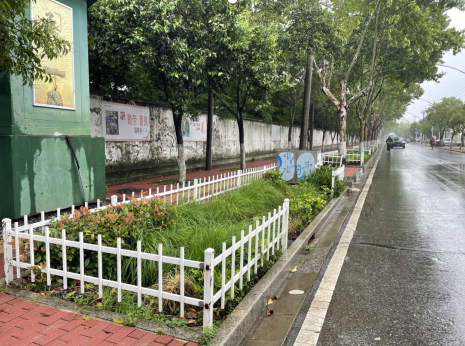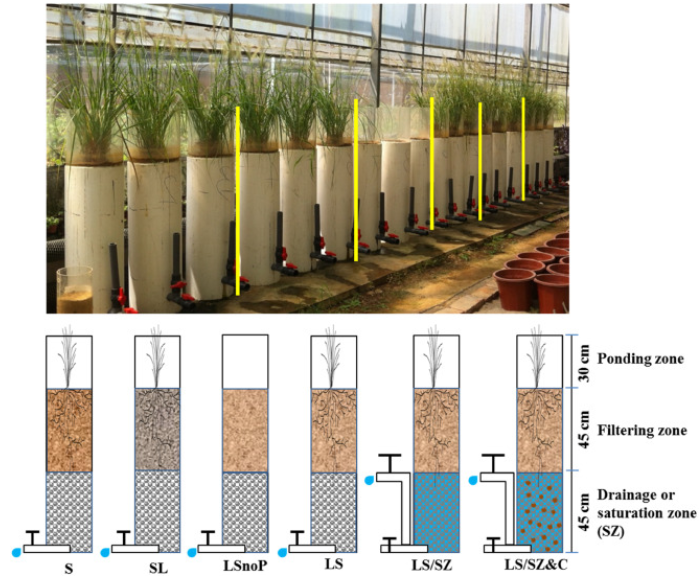On November 25, Water Research, a journal of Nature Index on environmental sciences, published the academic achievement---Unconventional microbial mechanisms for the key factors influencing inorganic nitrogen removal in stormwater bioretention columns with Huang Liuqin, a teacher from the State Key Laboratory of Biogeology and Environmental Geology, CUG, as the first author, Professor Jiang Hongchen as the first corresponding author, and Associate professor Li Liqing from School of Environmental Studies as the co-corresponding author.
Bioretention systems are environmentally friendly measures to control the amount of water and pollutants in urban stormwater runoff, and their treatment performance for inorganic N strongly depends on various microbial processes. However, microbial responses to variations of N mass reduction in bioretention systems are complex and poorly understood, which is not conducive to management designs. In the present study, a series of bioretention columns were established to monitor their fate performance for inorganic N (NH4+and NO3−) by using different configurations and by dosing with simulated stormwater events. The results showed that NH4+ was efficiently oxidized to NO3−, mainly by ammonia- and nitrite-oxidizing bacteria in the oxic media, regardless of the configurations of the bioretention systems or stormwater conditions. In contrast, NO3− removal pathways varied greatly in different columns. The presence of vegetation efficiently improved NO3−mass reduction through root assimilation and enhancement of microbial NO3− reduction in the rhizosphere. The construction of an organic-rich saturation zone can make the redox potential too low for heterotrophic denitrification to occur, so as to ensure high NO3− mass reduction mainly via stimulating chemolithotrophic NO3− reduction coupled with oxidation of reductive sulfur compounds derived from the bio-reduction of sulfate. In contrast, in the organic-poor saturation zone, multiple oligotrophic NO3− reduction pathways may be responsible for the high NO3− mass reduction. These findings highlight the necessity of considering the variation of N bio-transformation pathways for inorganic N removal in the configuration of bioretention systems.
The research was funded by the National Natural Science Foundation (China) and the "111" talent program.

Fig. 1. Stormwater bioretention columns by the roadside

Fig. 2. Image showing six types of bioretention columns, each with triplicates. Different types of bioretention columns were composed of different filler media: columns composed of sandy, sandy-loamy, and loamy-sandy filler media were labeled with S, SL, and LS, respectively (See details in Table S1). Pennisetum alopecuroides was planted on the top of columns except LSnoP). Saturation zone was installed in the columns of LS/SZ and LS/SZ&C. Woodchips were mixed in the saturation zone of LS/SZ&C columns.

Fig. 3. Summary schematic illustration of microbial transformation pathways on NH4+ and NO3−affected by bioretention system configuration: (A) in the barren (no plant or saturation zone) NH4+ can be completely aerobically oxidized into NO3− in the ventilated media, while only small portion of NO3− can be reduced, which results in large quantity of NO3− in effluents; (B) when vegetation is applied, part of NH4+/NO3− is absorbed by plant roots and assimilated as organic nitrogen (ON); leftover NH4+is also completely aerobically oxidized into NO3−, and NO3− reduction in the rhizosphere can be considerably improved in the aerated media, which decreases the amount of output NO3−; (C) when a oligotrophic saturation zone (poor in organic substrates) is added, redox potential in the saturation zone is significantly low (suboxic), which favors additional reduction of NO3− in the SZ, but the NO3− bioreduction microorganisms and pathways are undefined and may be quite different from heterotrophic denitrification in the media; (D) when organic matter (OM) is amended in the saturation zone, much lower redox potential (anoxic) can be achieved, which induced anaerobic SO42− reduction (SO42−→HS-) and methanogenesis (OM→CH4); under such reductive condition NO3− is strongly reduced via S-dependent chemolithotrophic denitrification.
Title: Unconventional microbial mechanisms for the key factors influencing inorganic nitrogen removal in stormwater bioretention columns
Authors: Liuqin Huang, Junyue Luo, Linxin Li, Hongchen Jiang*, Xiaoxi Sun, Jian Yang, Weiyu She, Wen Liu, Liqing Li*, Allen P. Davis
Source:Water Research
DOI:10.1016/j.watres.2021.117895
Available online:25 November 2021
Link to the paper: https://www.sciencedirect.com/science/article/pii/S0043135421010897?via%3Dihub